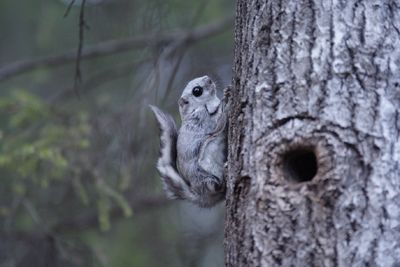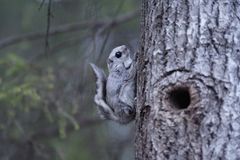The forestry sector needs to do more to ensure the future of the flying squirrel

A new Finnish study shows that current forestry instructions on leaving small wooded patches in clear-cut areas are not enough to protect the breeding of the flying squirrel. Collaboration between ecologists at the Finnish Museum of Natural History of the University of Helsinki, the University of Oulu and the University of Turku showed that flying squirrels disappear from almost all the tree cavities and nest boxes in which they live on current logging sites.
In unlogged forests in the same area, the flying squirrel population remained unchanged. At logging sites, the amount of suitable habitat within a 200-meter radius dropped to about one-half of the previous amount and within a 100-meter radius to about one-third. The study was published in the internationally renowned journal Biological Conservation in January 2013.
- Statutory conservation measures have been often implemented and have achieved mixed success, but unfortunately their impact is rarely assessed, laments Senior Curator Ilpo K. Hanski of the Finnish Museum of Natural History.
- This study was carried out in the Ostrobothnia region of western Finland, but similarities between forest management and the habitat requirements of the flying squirrel mean that the results likely apply across much wider areas Hanski continues.
Researchers hope that the new results will lead to a review of current logging instructions.
- My colleagues and I strive to participate more actively in the public discussion. Studies such as this one that test current practices are likely to encourage debate says Andrea Santangeli from the Finnish Museum of Natural History, a doctoral student and the lead investigator of the study.
An assessment of threatened species in 2010 indicates that the Finnish population of flying squirrels is still declining. The most important reason is likely related to modern forestry practices.
EU legislation guides the protection of species under the Habitats Directive. According to Finnish forestry rules from 2004 at least 0.03–0.07 hectares of habitat suitable for breeding and/or resting flying squirrels should be left in clear-cut areas. The remaining wooded patches must also be connected to a larger wooded area with an ecological corridor in which the distance between trees does not exceed their height.
The flying squirrel needs an old-growth mixed forest for breeding. It usually nests in holes of large aspens, while spruce trees provide protection. The home range of the males is about 60 hectares, whereas the females move in an area of only eight hectares. The flying squirrel can also use boxes if available in suitable habitats.
Further information:
Senior Curator Ilpo K. Hanski
Finnish Museum of Natural History
Tel. (09) 191 28853
ilpo.hanski@helsinki.fi
Keywords
Contacts
Laura HiisivuoriTiedottaja, LUOMUS
Tel:+358 576 2960laura.hiisivuori@helsinki.fiImages

Links
About Helsingin yliopisto
 Helsingin yliopisto
Helsingin yliopistoPL 3
00014 Helsingin yliopisto
02941 22622 (mediapalvelu) 02941 911 (vaihde) (vaihde)https://www.helsinki.fi/fi/yliopisto
Helsingin yliopisto on yli 40 000 opiskelijan ja työntekijän kansainvälinen yhteisö, joka tuottaa tieteen voimalla kestävää tulevaisuutta koko maailman parhaaksi. Kansainvälisissä yliopistovertailuissa Helsingin yliopisto sijoittuu maailman parhaan yhden prosentin joukkoon. Monitieteinen yliopisto toimii neljällä kampuksella Helsingissä sekä Lahden, Mikkelin ja Seinäjoen yliopistokeskuksissa. Lisäksi sillä on kuusi tutkimusasemaa eri puolilla Suomea ja yksi Keniassa. Yliopisto on perustettu vuonna 1640.
Subscribe to releases from Helsingin yliopisto
Subscribe to all the latest releases from Helsingin yliopisto by registering your e-mail address below. You can unsubscribe at any time.
Latest releases from Helsingin yliopisto
Mielenterveyden häiriöt koskettavat valtaosaa suomalaisista26.6.2025 08:30:00 EEST | Tiedote
Arviolta 77 % naisista ja 70 % miehistä saa elämänsä aikana jonkin mielenterveyden, käyttäytymisen tai neurokehityksen häiriön diagnoosin. Yleisimmät häiriöt ovat ahdistuneisuus- ja mielialahäiriöt. Miehillä häiriö todetaan useimmiten ensimmäisen kerran jo 6-vuotiaana.
Maahanmuuttajataustaisilla pojilla suurempi riski masennus- ja ahdistusoireiluun – koululla on tärkeä rooli heidän tukemisessaan26.6.2025 08:00:00 EEST | Tiedote
Maahanmuuttajataustaiset lapset ja nuoret raportoivat useammin masennus- ja ahdistusoireita. Oireilta suojaavissa tekijöissä korostuu koulun ja läheisten ihmissuhteiden rooli nuoren elämässä.
Kuinka saada irti kuolleen hirven etuhampaat?23.6.2025 10:36:14 EEST | Tiedote
Uusi tutkimus selvittää, kuinka kivikautiset ihmiset hankkivat raaka-aineen hammasriipuksiin.
Alkoholi muuttaa alkion ensimmäisten solujen geenien toimintaa19.6.2025 09:02:38 EEST | Tiedote
Alkoholialtistus alkionkehityksen ensimmäisten viikkojen aikana muuttaa geenien toimintaa ja solujen aineenvaihduntaa. Maljakasvatuksessa selvisi, että herkimpiä alkoholille ovat hermoston ensimmäiset solut. Tutkimustulos tukee nykyistä suositusta lopettaa alkoholinkäyttö jo raskautta suunniteltaessa.
Uusi työkalu auttaa tunnistamaan koiran epilepsiakohtauksen17.6.2025 14:07:14 EEST | Tiedote
Uusi, uraauurtava työkalu auttaa koiranomistajia tunnistamaan lemmikkinsä kohtaukset tarkemmin ja voi nostaa koirien epilepsian tutkimuksen, diagnostiikan ja hoidon uudelle tasolle.
In our pressroom you can read all our latest releases, find our press contacts, images, documents and other relevant information about us.
Visit our pressroom